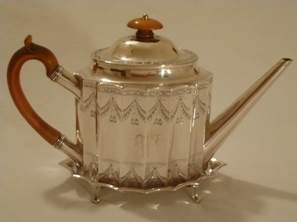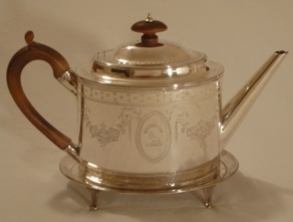by Joanne
and Emmett Eldred
(click on photos to enlarge image)
COLLECTING SILVER TEAPOTS AND STANDS
OUR COLLECTING GUIDELINES (2)
The following is the second in a series of papers, which
discuss several of the criteria we use in evaluating pieces we
collect. These discussions will highlight our approach when
considering form, originality of teapot and stand combinations,
engraving, hallmarks, condition, and crests & coats-of-arms. In
most cases we have used pictures from our modest but growing
collection to illustrate what is being described.
As is the case with collecting almost anything, the initial
learning curve can be quite steep. Being fairly new to the
subject it certainly applied to us. Our initial screen involved
only two basic areas; form and hallmarks. Our assessment of form
was subjective and based solely on our personal tastes at the
time. Of course having seen only a few examples we did not have
a broad reference base and therefore were unaware of the variety
of designs produced during the later part of the 18th century.
Our second screen was centered on hallmarks. As noted earlier,
one advantage in collecting English silver is its hallmarking
system. Fortunately we were able to locate several excellent
Websites for researching hallmarks, especially maker's marks.
Looking back on things we were very lucky with the majority of
our early purchases. We could have made some costly mistakes
because we did not realize that several other key factors, such
as crispness of the engraving, absence of repairs, surface
patina, presence of an identifiable coat-of-arms or crest, etc.,
significantly contributed to the desirability and therefore the
value of a set.
Over time we became more knowledgeable and ultimately developed
a pretty rigorous set of criteria for evaluating pieces we were
interested in purchasing. Our approach currently involves a
number of assessments (form, originality, engraving, hallmarks,
condition, crest), which we will describe over a series of
articles.
Part 2: ORIGINALITY
We try to only collect teapots with their "original" stands
so originality of the combination is a key factor for us. The
question of whether a teapot and stand were originally made as a
pair or mated later is probably the most difficult of our
assessments. At first blush, it would seem this determination
should be fairly straightforward and dependent on answering two
basic questions; "do the hallmarks match?" and "do the
engravings match?" However, after examining and studying
numerous examples one realizes this simplistic approach is
likely too restrictive. The real question should probably be "were
the teapot and stand paired contemporaneously or were they
paired at a significantly later date."
Since it is only recently that the value of these sets has
warranted their "marrying" for financial gain, it is usually
fairly easy to identify sets that were brought together during
the mid 1800s and most of the early 1900s. This is because there
was little incentive to deceive, since the primary goal for
marrying the two was merely to create an attractive pair. As
explored more fully later, there are a number of apparently
original sets that are date stamped a year apart. This seems
especially common for Hester Bateman, but also appears to be the
case for sets by many of the other makers of the period.
This is where subjectively becomes a factor, for example: "were
the teapot and stand made around the time of the date hallmark
turnover (around May-June in London)?"; or "did owners decided a
year or so after purchasing a teapot that they wanted a matching
stand and went back to the same or a different shop and had one
crafted?" ; or "was stand lost, stolen, or badly damaged and a
replacement crafted by the same or different shop?", or "were
there budgetary considerations so that owners purchased a plain
(no engraving) teapot first and then later the matching stand
and then even later had them both engraved?" The list of
possible scenarios could go on but in the end, it becomes an
individual's personal decision.
After careful consideration we have decided that, as in
archeology, it is the sum of all the data that is important for
our ultimate determination. As such, we are comfortable with
stands that are date marked a year after the teapot (especially
if all other criteria for original pairing check out). In some
unique cases the stand might even postdate the teapot by two
letters (which could possibly indicate slightly over one year
difference in manufacture) or the stand might predate the teapot
by one letter. However in both of these cases it takes a lot of
very solid evidence that the intent on the part of the
silversmith and/or the purchaser was that they were meant to be
a pair. Even though, in some cases, two different silversmiths
might have participated in creating a matched set for an owner,
we purposely exclude these examples, since there is no way of
knowing whether the two craftsmen collaborated in the creation
of the final statement.
The two examples pictured below are interesting study examples.
We consider both sets to be original even though the teapots and
stands are date coded one letter apart. We plan to offer a
detailed discussion of how we reached that conclusion in a
future post.

Robert Hennell 1789 and 1788
|

Hester Bateman 1788 and 1789
|
Joanne and Emmett Eldred
- 2011 -
|
|
|


